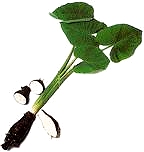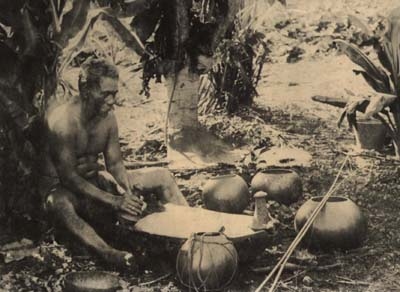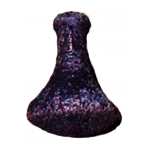FOOD! Why surf when you can eat?
 Welcome to our food recipes, links for native foods, and that wonderful poi! There is more about Poi in the link above under "What" - because Poi is so important and versatile! The terms “one finger, two fingers and three fingers poi” refer to the consistency; the thicker the poi, the fewer fingers needed to eat it.
Welcome to our food recipes, links for native foods, and that wonderful poi! There is more about Poi in the link above under "What" - because Poi is so important and versatile! The terms “one finger, two fingers and three fingers poi” refer to the consistency; the thicker the poi, the fewer fingers needed to eat it.
To see how ancient Hawaiians made poi, see Pounding Poi Movie .
 Coconut Ice Cream For those of you always open to new culinary adventures, here's a simple, non-dairy recipe for Coconut Ice Cream!
Coconut Ice Cream For those of you always open to new culinary adventures, here's a simple, non-dairy recipe for Coconut Ice Cream!
2 14-oz. cans (about 3 ½ c.) unsweetened coconut milk
1 c. sugar
½ tsp. salt
In a heavy saucepan, combine the coconut milk, sugar and salt. Place over medium-high heat and bring to a boil, stirring often to dissolve the sugar and salt. Remove from heat and pour into a bowl. Cover the bowl and refrigerate until very cold, about 2 hours. Freeze in an ice cream maker and serve at once, or transfer to an airtight container and store in the freezer for up to 3 weeks.
Check out this link: http://www.thepoicompany.com/
 A Brief History of Taro & Poi Poi, the staple of the traditional Hawaiian diet, is made from taro, an ancient root crop grown throughout the Tropics for its edible corms and leaves. Early Hawaiians not only used the taro plant for food, but also utilized the various parts for medicinal purposes; treating ailments ranging from insect bites and fevers to heart problems and stomach disorders.
A Brief History of Taro & Poi Poi, the staple of the traditional Hawaiian diet, is made from taro, an ancient root crop grown throughout the Tropics for its edible corms and leaves. Early Hawaiians not only used the taro plant for food, but also utilized the various parts for medicinal purposes; treating ailments ranging from insect bites and fevers to heart problems and stomach disorders.
Poi was made by mashing cooked, peeled taro corms with a stone pestle, or “poi pounder”. Water was added until the poi was smooth and sticky. The poi was then allowed to age and ferment, acquiring a “sour” tang.
 The terms “one finger, two fingers and three fingers poi” refer to the consistency; the thicker the poi, the fewer fingers needed to eat it. To see how ancient Hawaiians made poi, see Pounding Poi Movie .
The terms “one finger, two fingers and three fingers poi” refer to the consistency; the thicker the poi, the fewer fingers needed to eat it. To see how ancient Hawaiians made poi, see Pounding Poi Movie .
Today, poi is made by manufacturers using modern production methods. Fresh poi is delivered to the markets in the early morning.
 Nutritional Value of Poi Poi was not only the staple carbohydrate in the diet of the early Hawaiians, but also served as an excellent source of vitamin B, calcium and phosphorous. Because of its small starch grains, poi is an easily digested carbohydrate - an excellent choice for infants, the elderly and those who must choose their diets carefully. In addition, poi has been found to be practically non-allergenic. Those allergic to milk or grains, such as wheat and rice, can often enjoy poi with no adverse reactions.
Nutritional Value of Poi Poi was not only the staple carbohydrate in the diet of the early Hawaiians, but also served as an excellent source of vitamin B, calcium and phosphorous. Because of its small starch grains, poi is an easily digested carbohydrate - an excellent choice for infants, the elderly and those who must choose their diets carefully. In addition, poi has been found to be practically non-allergenic. Those allergic to milk or grains, such as wheat and rice, can often enjoy poi with no adverse reactions.
Poi Nutrition Facts
Ingredients: Taro and water (Per Serving) % Daily Value
Serving Size: 1/3 cup (90g) with water: 5/8 cup (140g)
Calories: 70
Fat Calories: 0
Total Fat:
0g 0%
Saturated Fat:
0g 0%
Cholesterol:
0g 0%
Sodium:
30mg 1%
Total Carbohydrate:
18g 6%
Dietary Fiber:
2g 8%
Sugars:
0g 0%
Protein:
0g 0%
Vitamin A & C:
Less than 2%
Calcium: 2%
Iron: 4%
*Percent Daily Values are based on a 2,000 calorie diet.